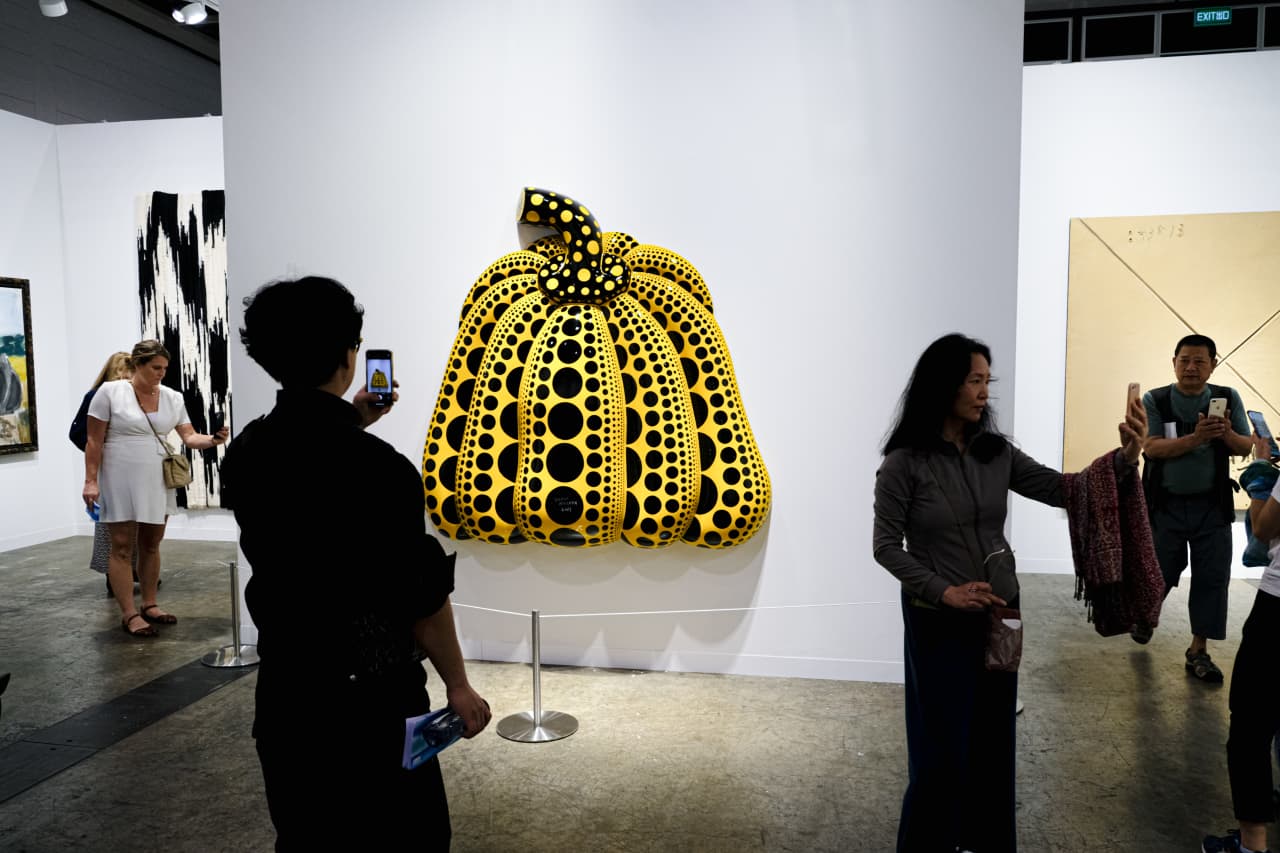Artworks by Yayoi Kusama collectively sold for nearly US$81 million last year at the major global auction houses, making her the top-selling 21st-century contemporary artist, according to the Hiscox Artist Top 100 report.
The boost in sales for Kusama’s works pushed David Hockney, the previous year’s top-selling artist, to second place. Hockney’s art garnered US$50.3 million in sales last year, down from US$74.7 million in 2022, said Hiscox, a London-based specialty insurer.
The second annual ranking, compiled with research and analysis from London-based ArtTactic, also showed Kusama’s No. 1 ranking was consistent with a strong showing by women artists overall last year. Joining Kusama among the top five last year was Cecily Brown, who ranked fourth with US$31.7 million in sales.
Yoshitomo Nara, ranked third with sales of US$36 million and George Condo ranked fifth with sales of US$29.5 million.
Total sales of contemporary art made after the year 2000 fell 17% to US$955 million last year from US$1.5 billion in 2022, according to the report. Though sales of contemporary art by women fell 8% to US$306 million, the number of works sold rose 21%. And sales by their male peers fell a much sharper 20%, the report said.
“The market for female artists has been much more resilient than that for male artists,” the report said.
The results go beyond ultra-contemporary art. Earlier this year, ArtTactic reported that overall sales of art by women at the major auction houses hit a record US$825.8 million last year, up 7% from a year earlier.
Another mark of progress: Art by women comprised 32% of 21st-century art auction sales last year, up from 29% in 2022, as the number of women artists behind these sales continued to climb. There were 728 women artists represented last year, up 179% from 2019, the report said.
“Contemporary female artists have always been undervalued and underrepresented,” Robert Read , head of art and private clients at Hiscox said in a news release. “Meaningful progress has been made in recent years, as the market gradually begins to recognise the importance and value of their work, but we are still some way from parity.”
Following Kusama and Brown, the top female artists by sales value were Julie Mehretu, with sales of US$21.4 million; Jadé Fadojutimi, with sales of US$8.5 million; and Jenny Saville, with sales of US$7.8 million.
The Hiscox report just examined the auction market for works created in the 21st century and sold at Christie’s, Phillips, and Sotheby’s. This segment was stronger than much of the art market last year, with sales still 26% above pre-pandemic levels. Sales of art made before 2000 have fallen 22% since 2019, the report said.
This segment of the market is also making up a larger share of all post-war and contemporary art sold at auctions, reaching 70% last year from 63% a year earlier.
The Hiscox report was consistent with other analyses of the art market last year that found large-ticket sales, over US$1 million, declined in favour of sales of works with price tags of US$50,000 or less.
Within the 21st-century art category, the number of lower-priced works sold gained 25% while the number sold above US$1 million fell by 12%. The trend is backed by a near doubling in the number of artists making 21st-century works that end up at auction since 2019, the report said.
The benefits of so-called flipping—or the practice of selling art made by young artists within two years of their creation—fell dramatically, bringing in US$39 million in sales last year from US$67 million in 2022. That’s despite the number of lots with this newly made art at 662 was about the same as the previous year.
Though Kusama is 95 years old, 41% of those making 21st-century art are under age 45, unsurprisingly. Leading this group of younger artists last year was: Nicolas Party, whose works sold for US$20.2 million; the late Matthew Wong, whose works sold for US$16.5 million; Fadojutimi; Caroline Walker, whose works sold for US$7.5 million; and Dmitri Cherniak, whose works sold for US$6.7 million.
 Copyright 2020, Dow Jones & Company, Inc. All Rights Reserved Worldwide. LEARN MORE
Copyright 2020, Dow Jones & Company, Inc. All Rights Reserved Worldwide. LEARN MORE
What a quarter-million dollars gets you in the western capital.
Alexandre de Betak and his wife are focusing on their most personal project yet.
CIOs can take steps now to reduce risks associated with today’s IT landscape
As tech leaders race to bring Windows systems back online after Friday’s software update by cybersecurity company CrowdStrike crashed around 8.5 million machines worldwide, experts share with CIO Journal their takeaways for preparing for the next major information technology outage.
Be familiar with how vendors develop, test and release their software
IT leaders should hold vendors deeply integrated within IT systems, such as CrowdStrike , to a “very high standard” of development, release quality and assurance, said Neil MacDonald , a Gartner vice president.
“Any security vendor has a responsibility to do extensive regression testing on all versions of Windows before an update is rolled out,” he said.
That involves asking existing vendors to explain how they write software, what testing they do and whether customers may choose how quickly to roll out an update.
“Incidents like this remind all of us in the CIO community of the importance of ensuring availability, reliability and security by prioritizing guardrails such as deployment and testing procedures and practices,” said Amy Farrow, chief information officer of IT automation and security company Infoblox.
Re-evaluate how your firm accepts software updates from ‘trusted’ vendors
While automatically accepting software updates has become the norm—and a recommended security practice—the CrowdStrike outage is a reminder to take a pause, some CIOs said.
“We still should be doing the full testing of packages and upgrades and new features,” said Paul Davis, a field chief information security officer at software development platform maker JFrog . undefined undefined Though it’s not feasible to test every update, especially for as many as hundreds of software vendors, Davis said he makes it a priority to test software patches according to their potential severity and size.
Automation, and maybe even artificial intelligence-based IT tools, can help.
“Humans are not very good at catching errors in thousands of lines of code,” said Jack Hidary, chief executive of AI and quantum company SandboxAQ. “We need AI trained to look for the interdependence of new software updates with the existing stack of software.”
Develop a disaster recovery plan
An incident rendering Windows computers unusable is similar to a natural disaster with systems knocked offline, said Gartner’s MacDonald. That’s why businesses should consider natural disaster recovery plans for maintaining the resiliency of their operations.
One way to do that is to set up a “clean room,” or an environment isolated from other systems, to use to bring critical systems back online, according to Chirag Mehta, a cybersecurity analyst at Constellation Research.
Businesses should also hold tabletop exercises to simulate risk scenarios, including IT outages and potential cyber threats, Mehta said.
Companies that back up data regularly were likely less impacted by the CrowdStrike outage, according to Victor Zyamzin, chief business officer of security company Qrator Labs. “Another suggestion for companies, and we’ve been saying that again and again for decades, is that you should have some backup procedure applied, running and regularly tested,” he said.
Review vendor and insurance contracts
For any vendor with a significant impact on company operations , MacDonald said companies can review their contracts and look for clauses indicating the vendors must provide reliable and stable software.
“That’s where you may have an advantage to say, if an update causes an outage, is there a clause in the contract that would cover that?” he said.
If it doesn’t, tech leaders can aim to negotiate a discount serving as a form of compensation at renewal time, MacDonald added.
The outage also highlights the importance of insurance in providing companies with bottom-line protection against cyber risks, said Peter Halprin, a partner with law firm Haynes Boone focused on cyber insurance.
This coverage can include protection against business income losses, such as those associated with an outage, whether caused by the insured company or a service provider, Halprin said.
Weigh the advantages and disadvantages of the various platforms
The CrowdStrike update affected only devices running Microsoft Windows-based systems , prompting fresh questions over whether enterprises should rely on Windows computers.
CrowdStrike runs on Windows devices through access to the kernel, the part of an operating system containing a computer’s core functions. That’s not the same for Apple ’s Mac operating system and Linux, which don’t allow the same level of access, said Mehta.
Some businesses have converted to Chromebooks , simple laptops developed by Alphabet -owned Google that run on the Chrome operating system . “Not all of them require deeper access to things,” Mehta said. “What are you doing on your laptop that actually requires Windows?”















